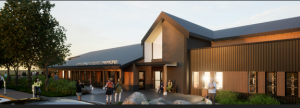A Vancouver architect is using ancient principles and practices to create cutting-edge wood structures. Formline Architecture principal Alfred Waugh highlighted several projects that utilize the principles of aboriginal architecture at the recent Wood Design and Construction Solutions Conference in Vancouver.
Wood plays a significant role in the design of these structures, Waugh said.
He pointed to the Squamish Lil’Wat Cultural Centre, which is designed in a similar manner to traditional longhouses.
"We wanted the building to be inviting and a way to share culture rather than a ‘black box,’" Waugh said. "We wanted a plank house, but a transparent one."
While the design is based on traditional themes, new wood technologies are employed to make architectural ideas a reality.
A hybrid post and beam system inspired by the plank house theme was created using paired glulam columns and beams joined by steel connectors and glulam rivets. It also used a suspended glazing system, which allowed for "shingled glass."
Another project, the O’Siyam Pavilion in Squamish, uses curved glulam to create a bandstand.
"It’s an expression of the locale, where the mountains meet the sea," Waugh said, reflected in the undulating shape of the roof.
Ventilation is another area where designers drew upon indigenous ingenuity. Longhouse design was again referenced for the First Peoples House at the University of Victoria, but the form of the structure also worked as a way to enable displacement ventilation.
"The design allows for passive cooling and uses 100 per cent fresh air," Waugh said.
The main air supply is provided through a "ventilation totem" outside the building, which sends air down to the mechanical ventilation systems. Computer fluid dynamic modelling was used to calibrate ventilation requirements to occupant load, Waugh added.
The building’s quadrangle shape is meant to integrate and blend in with the surrounding land, he said.
"It’s one of the few heavy timber buildings in the centre of the campus, surrounded by concrete buildings," Waugh said.
One of the most challenging projects Waugh worked on was the Liard River Hot Springs in Liard River, B.C. The project was a replacement for existing change room facilities and washrooms, but could not use any mechanical or electrical elements. Construction also had to have minimal impact to endangered snails living in the area.
"Lights were not allowed, so the structure makes use of natural light," Waugh said.
Teepees were used in the Nicola Valley for hunting and fishing, but their simple design also acts as a natural air funnel. For the Nicola Valley Institute of Technology building in Merritt, B.C., the climate elements of the building were based on that model.
Originally two separate entrances were planned for the building, but "an elder pointed out ‘we’ve been going through separate entrances for over 200 years,’ so we changed the design to one large entrance and a circular space in the middle," Waugh said.
The wood used was glulam columns supporting a concrete structure.
"A forest of columns replaced the forest of jack pines we had to displace," Waugh said.










Recent Comments
comments for this post are closed